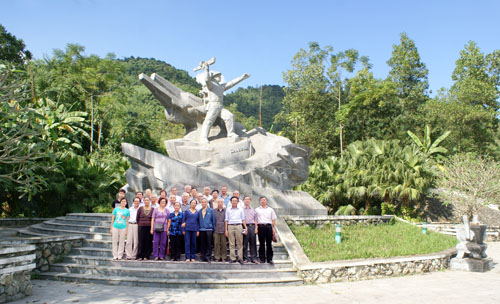
(HBO) - According to the statistics, up to now there are 57 cultural and historical relics ranked at the provincial level and 41 national relics in the whole province. Over the past time, the protection and promotion of the value of the cultural heritage have been paid attention to by all the levels and the appropriate authorities. The province has directed the districts and the city to strengthen the management of the relics and the organization of the festivals in 2020.
From the beginning of the year to April 2020, the functional branch has exhibited the thematic artifact "The pride of the 90 years of glorious tradition of the Communist Party of Vietnam” at the Provincial Museum to celebrate the 90th anniversary of its founding and the Year of the Rat in 2020. They have been restoring a number of typical folk games of the Muong ethnic group in Hoa Binh province to serve the People.
The Relic A2 Base - Nhan Dan newspaper in Luong Son district has been ranked as the provincial cultural and historical relics. The functional branch is submitting to the provincial People's Committee for granting a certificate of ranking the provincial cultural and historical relics for Dinh Khiet relic in Lac Son district. Additionally, they have made the survey and the record of 3 relics including Hang Song and Hang Hoang relics in Da Bac district and Dinh Khoi relics in Lac Son district. They have been rebuilding 2 ancient bronze drums in Yen Bong and deploying the project of restoring and embellishing the cultural and historical relics of Trung Bao Temple in Luong Son district and Chua Hang relics in Yen Thuy district. They have also completed the scientific documents of Dinh Bang area in Lac Son district. They also continue performing tasks of preserving and promoting the value of Mo Muong of Hoa Binh cultural heritage in 2020.
The People’s Committee of Lac Son district held a ceremony on April 28 to receive the provincial relic certificate for the ancient rock carving site at Suoi Co stream, located in My Thanh commune.
A special music show titled "The country is in the fullness of joy” has been held at Hoa Binh Square in Hoa Binh city in celebration of the 50th anniversary of the liberation of the South and national reunification (April 30, 1975–2025).
The People's Committee of Lo Son commune, Tan Lac district, has organised the local annual traditional stream fishing festival on April 19 - 20.
As a land deeply intertwined with human history and Vietnam’s millennia-long journey of nation-building and defence, Hoa Binh is often revered for its epic tales and legends.
Residents of Hoa Binh boast a rich cultural identity, reflected in their unique language, traditional attire, customs, and folk melodies – described as "sweet as honey, clear as a mountain stream.”
Lac Son district’s Vu ban town held the 2025 Truong Kha temple festival on April 12–13 (the 15th–16th days of the third lunar month). Since its revival in 2019, the festival has been organised every three years, preserving valuable intangible heritage while meeting the community’s cultural and spiritual needs.


